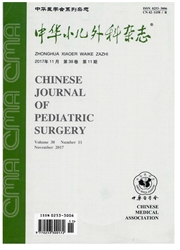

 中文摘要:
中文摘要:
目的应用跨胎盘RNA干扰技术抑制胚胎鼠EphB2基因,探索研究易感基因在先天性畸形中的作用。方法构建先天性肛门直肠畸形(anorectal malformation,ARM)相关易感基因EphB2下调质粒SiEphB2,设计3个不同位点SiEphB2,通过鼠尾静脉向孕鼠注射SiEphB2质粒,空载体及Ringer’s液。孕鼠在孕9.5d注射,48h后取出胚胎,应用实时定量PCR及Western blotting检测EphB2基因在子代鼠的mRNA和蛋白质表达水平。并观察新生鼠的肛门直肠发育情况。结果在mRNATk平,发现SiEphB2载体注射组(SiEphB2组)EphB2基因表达比较空载体注射组(Vector组)及释液注射组(Ringer’s组)明显降低。Ringer’s组均值为0.99±0.06,Vector组为0.87±0.07;SiEphB2组中,SiEphB2—1组均值为0.27±0.03,SiEphB2—2组为0.34±0.04,SiEphB2—3组为0.42±0.02。SiEphB2组胚胎EphB2基因较Ringer’S组和Vector组分别下调(65.3±6.6)%和(60.6±8.6)%,差异有统计学意义(P〈O.05)。在蛋白质水平,Ringer’s组为1.00±0.05,Vector组为0.93±0.09;SiEphB2组中,SiEphB2—1组为0.20±0.03;SiEphB2—2组为0.33±0.02;SiEphB2—3组为0.39±0.02。SiEphB2组胚胎EphB2基因较Ringer’s组和Vector组分别下调(69.3±7.8)%和(66.9±9.6)%,差异有统计学意义(P〈0.05)。大体观察SiEphB2组胎鼠可见肛门及鼠尾发育,矢状位切片HE染色未见ARM发生。结论胚胎鼠早期跨胎盘RNA干扰是研究基因功能现实可行的研究方法,跨胎盘SiEphB2可下调子代鼠基因。
 英文摘要:
英文摘要:
Objective To explore a predisposing gene research platform for congenital malformations in mice caused by transplacental RNAi-EphB2. Methods The EphB2 down-regulatory plasmid SiEphB2 and vector in Ringer's solution were delivered into tail vein of mice 9. 5 days of pregnancy. Plasmids for SiRNA contained three different sites of RNAi for silencing EphB2 gene. The embryos were removed 48 h after injection and real-time quantitative polymerase chain reaction (PCR) and Western blot were used for detecting the expression of EphB2. The anorectal development of newborn and l-week-old mice was observed. Results The expressions of EphB2 mRNA in all three SiEphB2 groups (SiEphB2-1 : 0. 27 ±0. 03 ; SiEphB2-2 : 0. 34 ± 0. 04; SiEphB2-3 : 0. 42 ±0. 02) were significantly lower than those in Ringel's group (0. 99 ±0. 06) and in vector group (0. 87 ±0. 07). The mRNA expression of EphB2 in SiEphB2 embryos was down-regulated by (65.3 ± 6. 6) % versus Ringers group and by (60. 6 ± 8. 6)% versus vector group (P〈0. 05). The expression of EphB2 protein in SiEphB2 groups (SiEphB2-1 : 0. 20 ±0. 03; SiEphB2-2: 0. 33 ±0. 02; SiEphB2-3: 0. 39 ±0.02) decreased markedly versus that in Ringer' s group (1.00 ± 0.05) and vector group (0.93 ± 0.09). The protein level of EphB2 decreased by (69. 3±7. 8)% in SiEphB2 embryo group versus Ringer's group and by (66. 9 ± 9. 6)% versus vector group(P〈0. 05). In SiEphB2 group, normal development of anus and tail was confirmed by gross observation and hematoxylin & eosin (HE) staining of sagittal section. No anoreetal malformation was found in SiEphB2 group. Conclusions Systemic delivery of SiEphB2 provides a valuable approach to gene silencing in embryos. words]
 同期刊论文项目
同期刊论文项目
 同项目期刊论文
同项目期刊论文
 期刊信息
期刊信息
